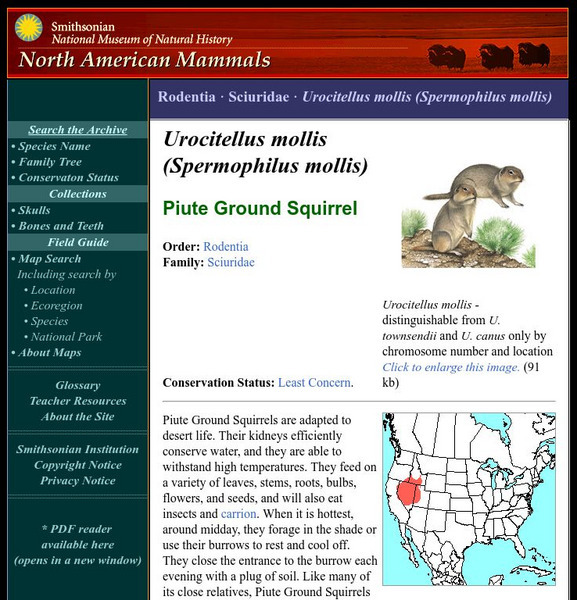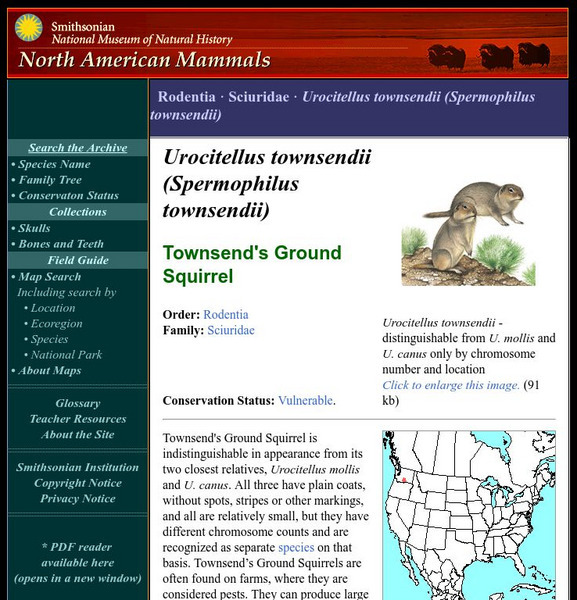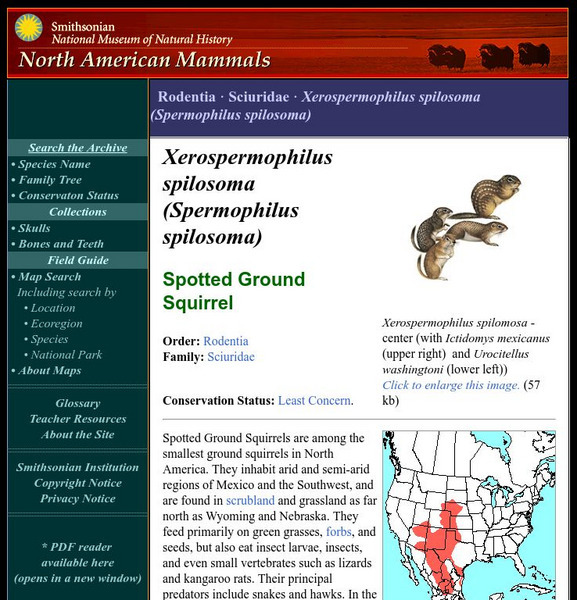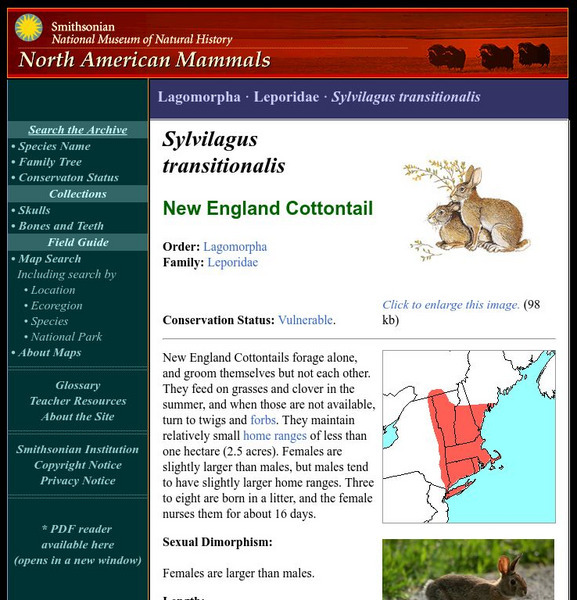Smithsonian Institution
National Museum of Natural History: American Mammals: Piute Ground Squirrel
Piute Ground Squirrels are adapted to desert life. Their kidneys efficiently conserve water, and they are able to withstand high temperatures. Learn more about the Spermophilus mollis, more commonly known as a Piute Ground Squirrel, in...
Smithsonian Institution
National Museum of Natural History: American Mammals: Washington Ground Squirrel
Since the massive conversion of land in the Columbia Basin to agriculture, the Washington Ground Squirrel has been in decline. During the 1980s, the number of localities where they were known to occur dropped from 179 to 35, all small in...
Smithsonian Institution
National Museum of Natural History: American Mammals: Rock Squirrel
Rock squirrels, with their long, bushy tails, look very much like tree squirrels, but seldom climb trees. They are most commonly found in rocky habitats: canyons, cliffs, and hillsides. Learn more about the Spermophilus variegatus, more...
Smithsonian Institution
National Museum of Natural History: American Mammals: Thirteen Lined Ground Squirrel
Thirteen-lined Ground Squirrels are often seen standing on their hind legs on roadsides or other places where grass is mowed, such as lawns, golf courses, or cemeteries. The squirrels probably once lived in short-grass prairie, and some...
Smithsonian Institution
National Museum of Natural History: American Mammals: Townsend's Ground Squirrel
Townsend's Ground Squirrel is indistinguishable in appearance from its two closest relatives, Spermophilus mollis and S. canus. Learn more about the Spermophilus townsendii, more commonly known as a Townsend's Ground Squirrel, in this...
Smithsonian Institution
National Museum of Natural History: American Mammals: Spotted Ground Squirrel
Spotted Ground Squirrels are among the smallest ground squirrels in North America. They inhabit arid and semi-arid regions of Mexico and the Southwest and are found in scrubland and grassland as far north as Wyoming and Nebraska. Learn...
Smithsonian Institution
National Museum of Natural History: American Mammals: Mohave Ground Squirrel
The Mohave Ground Squirrel occupies a relatively tiny part of the Mohave Desert and is rarely seen since it spends more than half the year underground in a burrow. Estivation, the hot-weather equivalent of hibernation, and hibernation...
Smithsonian Institution
National Museum of Natural History: American Mammals: Wyoming Ground Squirrel
Wyoming Ground Squirrels are found in three separate regions of the western United States at elevations above 1,500 meters. Their geographic centers are in southwestern Montana, central and southwestern Wyoming, and southwestern Idaho,...
Smithsonian Institution
National Museum of Natural History: American Mammals: Uinta Ground Squirrel
Uinta Ground Squirrels can live seven years or longer, but few live more than four years. Predation is an important factor. Learn more about the Spermophilus armatus, more commonly known as a Uinta Ground Squirrel, in this easy-to-read...
Smithsonian Institution
National Museum of Natural History: American Mammals: Merriam's Ground Squirrel
Merriam's Ground Squirrels live in high desert habitat dominated by big sagebrush, western juniper, and greasewood, and are also found in grasslands and agricultural lands. They eat grasses and forbs. Learn more about the Spermophilus...
Smithsonian Institution
National Museum of Natural History: American Mammals: Western Spotted Skunk
Eastern and Western Spotted Skunks were for years thought to be one and the same species, but they differ in an important detail of the reproductive process. In the Western Spotted Skunk, a very long period of delayed implantation...
Smithsonian Institution
National Museum of Natural History: American Mammals: Rock Pocket Mouse
As their name indicates, Rock Pocket Mice dwell in rocky habitats, and only rarely live in areas with sandy or silty soils. Their inconspicuous burrows are located near or under rocks, in rocky gulches or canyons, or near boulders. Learn...
Smithsonian Institution
National Museum of Natural History: American Mammals: Spinner Dolphin
Schools of spinner dolphins leap out of the water, twirl, and reenter with large, noisy splashes that can be heard for long distances underwater. Usually they make several such spinning leaps in a row. Learn more about the Stenella...
Smithsonian Institution
National Museum of Natural History: American Mammals: Striped Dolphin
The striped dolphin is the largest of the five relatively small dolphins in the genus Stenella. Shy and wary of boats in some areas of the Pacific, and seen riding the bow waves of boats in other places, these dolphins make long, shallow...
Smithsonian Institution
National Museum of Natural History: American Mammals: Rough Toothed Dolphin
Rough-toothed dolphins are usually seen swimming in schools of 10-20 individuals, although groups of 50 or more have been reported. They are sometimes seen cruising along at high speed, with their beaks at the surface and their dorsal...
Smithsonian Institution
National Museum of Natural History: American Mammals: Swamp Rabbit
The Swamp Rabbit is the largest North American cottontail, but has relatively short ears in proportion to its size. It forages for grasses, sedges, some tree seedlings, and other plants in marshy lowlands of the south-central United...
Smithsonian Institution
National Museum of Natural History: American Mammals: New England Cottontail
New England Cottontails forage alone, and groom themselves but not each other. They feed on grasses and clover in the summer, and when those are not available, turn to twigs and forbs. Learn more about the Sylvilagus transitionalis, more...
Smithsonian Institution
National Museum of Natural History: American Mammals: Marsh Rabbit
Marsh Rabbits live only in marshy areas, and like Swamp Rabbits, are good swimmers. They are often found in habitats with pools of brackish water and plants such as cattails, water hyacinth, rush, centella, and marsh pennywort. Learn...
Smithsonian Institution
National Museum of Natural History: American Mammals: Mountain Cottontail
At dawn and dusk in the mountainous regions of the western United States, the Mountain Cottontail forages for sagebrush, western juniper, and grasses, almost always close to cover. As befits a rabbit that lives where it gets very cold,...
Smithsonian Institution
National Museum of Natural History: American Mammals: Southern Bog Lemming
Southern Bog Lemmings are born with whiskers and a scattering of hairs on their heads and backs. They are well-furred when they are a week old, and look like miniature adults at two weeks of age. Learn more about the Synaptomys cooperi,...
Smithsonian Institution
National Museum of Natural History: American Mammals: Northern Bog Lemming
Northern Bog Lemmings have a large geographic range, but they are seldom encountered, and the reason for their apparent scarcity is not known. Their preferred foods - sedges and grasses - are abundant, and they do not have very limiting...
Smithsonian Institution
National Museum of Natural History: American Mammals: Merriam's Chipmunk
Merriam's chipmunk's calls are distinctive. Perched on top of a stump or rock, the chipmunks vocalize long and vigorously, and the "chip" sound is often followed by a burst of sound called a "terminal pulse. Learn more about the Tamias...
Smithsonian Institution
National Museum of Natural History: American Mammals: Long Tailed Pocket Mouse
The range of the Long-tailed Pocket Mouse is mostly within the Mojave Desert, Colorado Desert, and the Great Basin. On cold nights, this animal becomes inactive and usually remains within its burrow system during winter. Learn more about...
Smithsonian Institution
National Museum of Natural History: American Mammals: Yellow Cheeked Chipmunk
Yellow-tailed chipmunks are common in California's dark, moist giant redwood forests. These relatively large chipmunks are hard to see but they can be recognized by a unique call given when intruders are present. Learn more about the...























